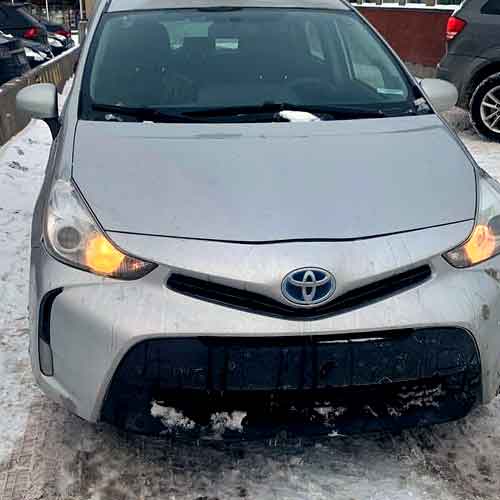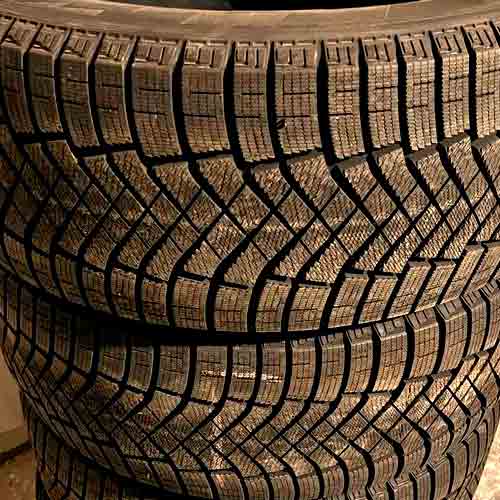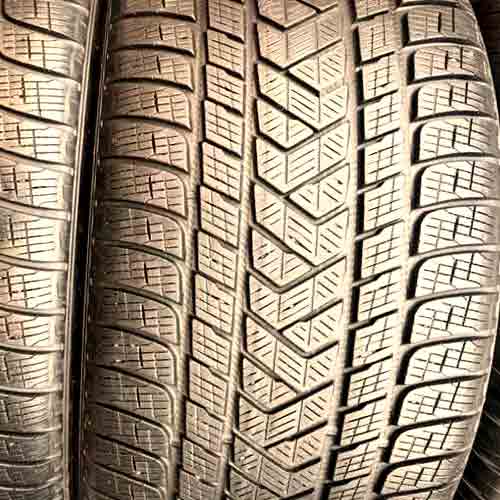The competition is on as Pirelli Scorpion Winter, noted for its comfort and durability, challenges Pirelli Ice Zero FR, hailed for its fantastic handling. Let’s uncover which tire will dominate the winter roads!

Table of Contents
Fuel Usage
Fuel efficiency in tires is fundamentally linked to tread design and structural weight as these elements determine the rolling resistance, which directly affects fuel consumption.
In this aspect, both tires showcase similar levels.
Although the Pirelli Ice Zero FR flaunts a lighter overall structure (averaged across all sizes), it has slightly wider tread voids which instigate additional lug movement during maneuvers, requiring extra fuel consumption.
However, this effect is counterbalanced by the Pirelli Scorpion Winter, which, despite its heavier weight applying more pressure on the lugs, results in similar levels of fuel consumption.
Consequently, in terms of fuel economy, it’s a deadlock between the two tires.
Tread Life
The lifespan of a tire’s tread is an amalgamation of various factors such as the tire’s weight, the depth of the tread, its design, and the makeup of its compound. And considering these variables, it’s not surprising to see the Pirelli Ice Zero FR outshining others in this facet.

The Pirelli Ice Zero FR carries a lighter weight, which means each of its individual lugs are subjected to lesser pressure, resulting in minimized friction as they interact with the road’s surface.
And adding to this, the tire features enhanced tread depth. (This quality is advantageous as the deeper the tread voids, the more time it will require for the tire to wear down to its replacement stage).
On the contrary, while the Pirelli Scorpion Winter profits from a somewhat sturdier tread compound that fights against wear, its overall tread life still falls short when juxtaposed with the Pirelli Ice Zero FR.
Comfort Levels
Ride comfort can be essentially boiled down to the reduction of noise and the tire’s ability to absorb shocks from the road.
Discussing noise first, it’s primarily generated when air particles collide with the walls of the tread. In simpler terms, larger tread gaps tend to give rise to a noisier tire.
In this respect, the Pirelli Scorpion Winter enjoys an advantage with its more compact design.

Moreover, the tire employs a superior pitch sequencing technology where alterations in the tread block geometry induce the creation of different tones by air particles. These tones then cancel each other out, leading to a reduction in noise.
On the other hand, the Pirelli Ice Zero FR excels in quelling vibrations, owing to its softer overall tread compound.
Its relatively supple tread composition boosts its shock-absorbing capabilities, assuring a smoother ride.
Thus, while the Pirelli Ice Zero FR offers superior performance in terms of impact comfort, the Pirelli Scorpion Winter renders a quieter ride, with each tire shining in their respective comfort zones.
Fluffy Snow Traction
In conditions of soft snowy landscapes, the Pirelli Scorpion Winter manages to notch ahead slightly, and it accomplishes this, through its expansive assortment of gaps or biters that act as snow traps.
These snow traps foster a robust snow-to-snow bond, which forms the tire’s contact patch with the ground, thus enhancing traction. This effect stems from the fact that snow adheres more effectively to itself than it does to rubber.
In comparison, the Pirelli Ice Zero FR lacks these particular attributes.
Although its tread pattern is also directional, it misses the sleek effect of the Pirelli Scorpion Winter, diminishing its effectiveness in ejecting snow to create forward thrust.
Additionally, a closer examination of its tread reveals that it doesn’t possess as many interconnected tread voids as its rival, leading to less efficient snow-to-snow contact.
Wet Grip
Upon testing, both tires exhibit similar wet braking distances (calculated on average), implying comparable grip levels. However, when it comes to handling, the Pirelli Ice Zero FR slightly outshines its counterpart.
This advantage is primarily due to the tire’s superior water clearance capabilities, credited to its multi-angled sipes and notches, which are facing both lateral and longitudinal directions on the tread. This design facilitates grip in all directions when cornering, minimizing the risk of slippage.
In contrast, the Pirelli Scorpion Winter, which only has laterally oriented sipes on its shoulders, shows a deficiency in overall handling times during testing.
Dry Traction
The overall dry performance of a tire depends on two aspects, directional grip, and handling.
Directional grip’s effectiveness predominantly lies in the central region of the tread, and it makes sense why the Scorpion Winter with more closed up pattern there offer better overall efficacy.
Even though both tires are equipped with robust foundations underneath the central lugs, the Scorpion Winter still manages to provide greater rubber to road contact, resulting in a remarkable 4 feet reduction in average braking distance in tests compared to the Pirelli Ice Zero FR.
Though the opposite happens, when the handling is considered, which relies primarily on the tire’s shoulder design and total weight.
Here, the Pirelli Scorpion Winter having a heftier structural weight is at a disadvantage.
Its greater weight induces increased lug movement during cornering, thereby compromising steering feedback.
On the contrary, the lighter Pirelli Ice Zero FR ensures a more harmonious balance between understeering and oversteering, enhancing overall steering responsiveness.
Ice Traction
In icy conditions, the Pirelli Ice Zero FR holds the upper hand, as it offers more biters per surface area of its tread, including an array of various sipes, and multi-angled notches.
This allows the tire to brake 4 feet faster, on average.
Conversely, the Pirelli Scorpion Winter, although featuring plenty of in-groove notches, lacks an aggressive siping design.
And yes, it rubber is also not that flexible as well, so all its biters don’t get to grip on ice with as much efficacy as seen on its counterpart.
Summing Up
So, what are the key takeaways?
Evidently, each tire excels in distinct areas.
The Pirelli Scorpion Winter shines on snowy terrain due to its extensive snow traps and streamlined tread design, providing superior snow traction. Plus, this tire offers better directional traction on both wet and dry roads
Conversely, the Pirelli Ice Zero FR outperforms in icy conditions due to its specialized biters and comprehensive grip from multiple angles. And this tire features superior handling capabilities in both wet and dry.
In terms of treadwear, the Pirelli Ice Zero FR comes out better, offering longer tread life.
And fuel economy is almost similar on both.